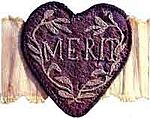Purple Heart

The Purple Heart is a United States military decoration. It is awarded in the name of the President to those wounded or killed, while serving, on or after April 5, 1917, with the U.S. military.[a] It is the successor to the Badge of Military Merit, which took the form of a heart made of purple cloth. The Purple Heart is the oldest military award still given to U.S. military members. The National Purple Heart Hall of Honor is located in New Windsor, New York.
History[change | change source]

The original Purple Heart, called the "Badge of Military Merit", was established by George Washington in 1782.[2] The Badge of Military Merit was only awarded to three Revolutionary War soldiers. If any more had been awarded, any records of being given that award have been lost.[2] The badge was never abolished, it was just forgotten about until after World War I.[3]
In 1932 General Douglas MacArthur urged the revival of the Purple Heart medal and he was awarded the first one.[4] The War Department authorized the medal under General Order Number 3. The award was "to be awarded to persons who, while serving in the Army of the United States perform any singular meritorious act of extraordinary fidelity or essential service."[5]
With the establishment of the Legion of Merit award, the Purple Heart was no longer awarded for meritorious service. By Executive Order 9277, dated December 3, 1942, the award was to only be given for wounds received. Additional Executive orders added circumstances where the award can be given. In 1962 it was ordered the medal could be given posthumously (after the person died). A 1984 change allowed the award to be given for wounds received as a result of terrorist attacks or while serving as part of a peacekeeping force. In 1986 public Law 99-145 authorized the award for wounds received as a result of friendly fire.[6]
Because the medal was given out during many conflicts, the exact number of Purple Hearts awarded is not known.
Order of Precedence[change | change source]
The Purple Heart medal is worn on the uniform after the Bronze Star Medal.[7] It is to be worn before the Defense Meritorious Service Medal.[7] In the Army and Air Force when a second or more Purple Heart is awarded, oak leaf clusters are used. The Navy, Marine Corps, and Coast Guard use 5/16 inch stars to show multiple awards.[8]
Notes[change | change source]
References[change | change source]
- ↑ Military Order of the Purple Heart, The Legacy of the Purple Heart (Paducah, KY: Turner Publishing Co.,2001), p. 20
- ↑ 2.0 2.1 Fred L. Borch III, Medals for Soldiers and Airmen: Awards and Decorations of the United States (Jefferson, NC: McFarland & Company, Inc., Publishers, 2013), p. 137
- ↑ "Purple Heart". The Institute of Heraldry. Archived from the original on 3 December 2013. Retrieved 6 June 2011.
- ↑ James G. Thompson, Complete Guide to United States Marine Corps Medals, Badges, and Insignia: World War II to present (Fountain Inn, SC: MOA Press, 2006), p. 72
- ↑ Fred L. Borch III, Medals for Soldiers and Airmen: Awards and Decorations of the United States (Jefferson, NC: McFarland & Company, Inc., Publishers, 2013), p. 140
- ↑ United States Code, 2006, (Washington, DC: United States Government Printing Office, 2008), p. 1131
- ↑ 7.0 7.1 Tim Zurick, Army Dictionary and Desk Reference (Mechanicsburg, PA: Stackpole Books, 2010), p. 284
- ↑ "Manual of Military Decorations and Awards: DoD-Wide Performance and Valor Awards; Foreign Awards; Military Awards to Foreign Personnel and U.S. Public Health Service Officers; and Miscellaneous Information" (PDF). DoD Manual 1348.33, Vol. 3. Department of Defense. Archived from the original (PDF) on 26 February 2013. Retrieved 31 July 2012., p. 24

